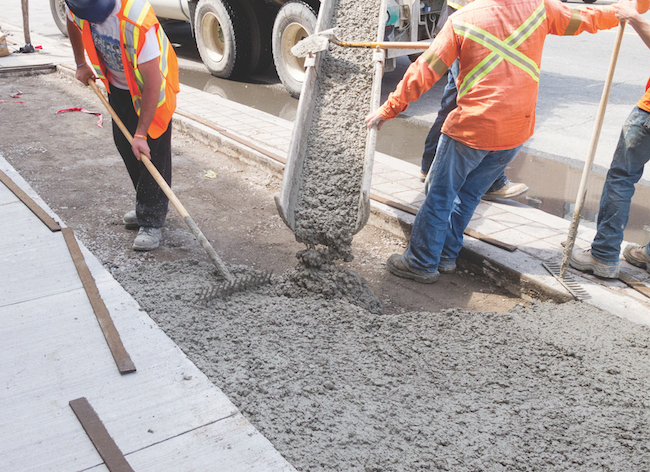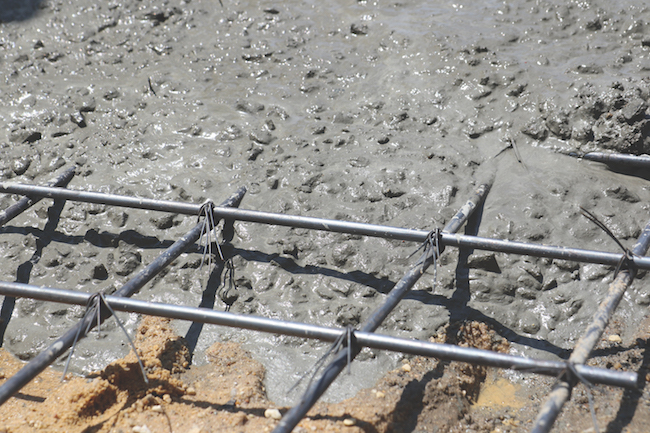
Adding to the mix: Using admixtures to get your concrete to do what you want it to
By David Kennedy
Concrete Construction Construction Materials
The Pantheon in Rome has remained the largest unreinforced concrete dome in the world for nearly 2,000 years. PHOTO: Getty Images
Looking up at the coffered dome of the Roman Pantheon, several thousand tonnes of ancient concrete overhead, the majesty of the nearly 2,000-year-old temple is lost on few. The building’s dome, still the largest unreinforced concrete dome in the world, spans 43-metres (142-feet) and contains a striking central opening, known as an oculus, wide enough to drive a pair of buses through.
What’s less obvious about the remarkably well intact piece of architecture is the composition of its concrete. While the basic recipe of Roman concrete has been an open secret for centuries, contemporary researchers have only recently deciphered the specifics.
Unlike modern concrete, which is built around Portland cement, the resilience of the mighty Mediterranean empire’s concrete relied on the use of silica-rich volcanic ash as an additive.
Concrete admixtures today take on similar, though far more diverse, roles. They offer properties like faster or slower set times, improved workability and added strength.
“It’s pretty common right across the board now,” says Brian Salazar, national business development manager for Canada at the Euclid Chemical Co. “I don’t think there’s a metre of concrete that goes out that doesn’t have at least a basic water reducer in it.”
Along with cutting down on the amount of water needed, water reducing admixtures let ready-mix producers use less costly cement while providing concrete crews with an equally workable mix.

Air entraining admixtures are another nearly ubiquitous component of modern concrete, particularly in Canada, according to Jordan Jancev, regional sales manager for Western Canada with TM Concrete, a unit of Sika Canada Inc. With frequent freeze and thaw cycles through winter, air entrainers enhance durability.
“Having admixtures in a cementitious mix can certainly maintain the quality… through the phases of mixing of the mix, transporting, placing, handling and curing in adverse weather conditions,” Jancev says, adding that these additives typically reduce the cost of the entire construction process. “It’s a benefit for everyone — starting from the producer of the concrete, whoever is handling that concrete and certainly the end-user, the owner.”
MORE THAN WATER, CEMENT AND AGGREGATE
It’s a familiar story in many big Canadian cities — an accident backs up traffic and suddenly, a trip that should have taken an hour takes two. Luckily, there’s an admixture for that.
Ross Monsour, the Ontario sales representative for concrete admixtures at Mapei Inc., pointed to set retarders and accelerators as two other key additives that let crews customize concrete for their specific job.
“When you’re pouring downtown Toronto, or somewhere like that and you want it off the truck quick, or you’ve been in traffic for two hours and it’s supposed to be off the truck, you’ve got to put in some admixtures to actually retard the mix, so it can be dumped a little later,” he says.

Particularly in urban areas and among larger general contractors, Monsour notes the use of a broader range of admixtures is really taking off. Water reducers, air entrainers and accelerators/retarders are well on their way to becoming standard, he says.
Superplasticizers aren’t far behind, though their higher cost limits their use to more specific applications, such as concrete walls or columns that require a lot of rebar. Here, Salazar says, the goal is producing strong, workable concrete with as little water as possible. Also known as high-range water reducers, superplasticizers can cut the amount of water in the mix by anywhere from 15 to 30 per cent, compared to five to eight per cent for a conventional water reducer.
“A typical metre of concrete might take 150 litres of water,” Salazar says. “If we can now put in only say 110 or 120 litres of water, we can give you very strong concrete, but with the plasticizer, we can still give you workable concrete. If you were to try and mix that concrete with only 120 litres of water, it would be dry and unworkable.”
With improved performance, the industry continues to embrace new ways of working.
“Some contractors will balk at the idea of paying a premium for their concrete and they’ll try to do the same sort of thing that they could be using a plasticizer for, but they’ll try and just use regular concrete and vibrate or manipulate it in some way to make it work,” Salazar says. “These days, most of the contractors understand you get a benefit from using these higher-end admixtures.”
At the same time, the major concrete admixture suppliers, which generally work with ready-mix producers as opposed to directly with contractors, are developing the next generation of additives.
At Sika, for instance, three per cent of the company’s revenue is poured back into research and development each year. The company has nearly 400 people working on innovations for concrete and other cementitious systems at its main research hub in Zurich, Jancev says. He adds that many of the ideas for new products stem from feedback from contractors looking for concrete that pours and sets in certain ways.
FORGOING THE MESH
One area that’s been gaining traction in the concrete market in recent years is the use of reinforcing fibres. Though separate from traditional admixtures, which are chemical additives in liquid or powder form, fibres represent an important step forward.
Typically plastic or steel, fibres can enhance the structural integrity of the finished product, reduce plastic shrinkage when concrete sets and eliminate some of the on-site mishaps when using rebar and wire mesh, Monsour says.

“Wire mesh, to be effective, has to sit in the top one-third layer of concrete,” he says. “But if you can imagine a slab being poured, the guys are standing on the wire mesh and pushing it right down. So, now when you combine the fibres right in the actual concrete, they’re dispersed uniformly and it avoids that problem. Then, you’re minimizing the cracking and shrinking that actually happens.”
Polypropylene microfibres are often put to use on residential jobs such as garage slabs, while sturdier macrofibres about five centimetres (two inches) long can better enhance structural integrity. “These provide a much stronger bind for the concrete to hold it together,” Monsour adds. “They actually can replace steel rebar.”
Steel fibres, which like their plastic counterparts are added to the mix at a ready-mix plant, can strengthen the concrete even further. Coming at a higher cost, however, they’re often reserved for heavier-duty applications like industrial concrete floors that must sustain the continual stress of heavy equipment.
Both steel and synthetic fibre reinforcement is also increasingly common for shotcrete, or sprayed concrete mixes, an application that’s finding broader use both in tunnelling projects and beyond.
THE NEXT WAVE
Meanwhile, many additive firms are experimenting with combining separate admixtures and fibres to form hybrid solutions.
At Mapei for instance, Monsour points to a new mix for jointless floors that incorporates an expansive admixture, shrinkage-reducer, superplasticizer and fibres.
The company also recently released an unconventional mix called Re-Con Zero. Unlike a typical admixture, the new product takes concrete returned to the plant and makes use of it.
“It turns it into an aggregate about a Granular B size in about six minutes so that it can be reused for fill [or] blended with certain concrete mixes,” Monsour says. “There’s an economic savings to the producer. Or if he gets a full load rejected, this stuff can turn it all back into an aggregate.”
Similarly, Sika is working on a range of innovations to its current product line, as well as entirely new products. Jancev says admixtures to improve the water permeability of concrete and new polymers that will be much better than those currently available are all in the pipeline.

At the same time, Euclid is tackling challenges posed by the harsh Canadian winter. Last year, the company introduced a new weatherproofing admixture known as Eucon Baracade WPT. A water repelling admixture, the additive reduces the potential for weather-related damage such as surface scaling and spalling.
While the focus is often on enhancing the finished product, admixtures also have a role to play in the global push to reduce carbon dioxide emissions.
It’s no secret the energy-intensive process to produce cement and by extension, concrete, generates between five and eight per cent of worldwide CO2 emissions. Along with water reducers that allow ready-mix producers to cut down on cement, many are now adding slag cement or fly ash to reduce costs and emissions.
In the winter months, Salazar notes, about 10 per cent of the cement in a mix can be replaced with slag or fly ash, while in the summer, that figure can be as high as 30 per cent. “That again helps to reduce the carbon footprint and in a lot of LEED buildings they do want mixes that have upwards of 50 per cent replacement,” he says.
As building codes evolve to include emissions, chemical additives are likely to play an increasingly prominent role.
This article first appeared in the August 2019 issue of On-Site. Click here to read through the full issue.




